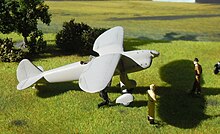Henschel Hs 121
| Henschel Hs 121 | |
|---|---|
 Henschel Hs 121 V1 |
|
| Type: | Trainer aircraft |
| Design country: | |
| Manufacturer: | |
| First flight: |
January 4, 1934 |
| Production time: |
1934 |
| Number of pieces: |
2 |
The Henschel Hs 121 was a German single-seat training aircraft for advanced training. The designation of official bodies was "exercise single seaters".
development
It was designed in 1933 by Friedrich Nicolaus and Hans Regelin and built by the Henschel-Flugzeug-Werke in Johannisthal on behalf of the RLM Reich Aviation Ministry , at the same time with two versions as low -wing aircraft in the same category and designated as Hs 125 V1 and V2 (plant no. 2 and 3), see this. For Walter Kneeser, who was intended as a works pilot but had a fatal accident in Rechlin, Scheubel Aerodynamisches Institut of the TU Darmstadt took off with the first test aircraft (works no. 1), the Hs 121 V1, for the first works flight on January 4, 1934. During a crash landing on January 30, 1934, the Hs 121 V1 was so badly damaged that it was no longer worth repairing. Instead, another Hs 121 was produced as a second test model under the serial number 7. It flew for the first time on September 24, 1934. The fuselage was reinforced, the vertical stabilizer was enlarged, the horizontal stabilizer was braced and an additional bracing was added to the fuselage. After several test flights, the Hs 121 V2, after it had received its registration D-EOVA, was sold together with the Hs 125 V2 (serial number 3) in October 1936 to the German Aviation Research Institute (DVL) and on December 10, 1936 in Schönefeld picked up.
construction
- Wing: shoulder wing construction with kink ; two-part, two-spar all-metal wing with partially fabric-covered undersides and ailerons; Landing flaps from the bend to the ailerons, operated by worm gear; both wing halves intercepted by two parallel handles.
- Hull: light metal hull in shell construction with oval cross-section; Motor accessible through large flaps
- Tail unit: simple, tensioned tail unit in all-metal construction, rudder fabric-covered
- Chassis: rigid tail wheel chassis; Main wheels on cantilever struts with Uerdinger ring springs, streamlined cladding, tail wheel also clad
- Powerplant: an air-cooled 8-cylinder V-engine of the type Argus As 10C with 240 HP take-off power; Two-blade adjustment propeller made of wood
Technical specifications
| Parameter | Data |
|---|---|
| crew | 1 |
| length | 7.30 m |
| span | 10.00 m |
| Wing area | 14.00 m² |
| height | 2.30 m |
| Empty mass | 710 kg |
| Takeoff mass | 960 kg |
| Top speed | 278 km / h |
| Service ceiling | 6500 m |
| Range | |
| Engines | 1 × Argus As 10C with 240 PS (177 kW) |
| Armament | - |
See also
literature
- Klaus Wartmann: Henschel aircraft 1933–1945 . Rockstuhl, Bad Langensalza 2011, ISBN 978-3-86777-407-9 , p. 8th ff .
Web links
Individual evidence
- ↑ German Patent No. 642548 Aircraft with rigid chassis struts extended into the fuselage
- ^ Aircraft development programs of the RLM in 1935
- ^ Henschel monthly reports
- ^ List of aircraft registered in the German aircraft register - additions in November 1936, published in Nachrichten für Luftfahrer 37 / 1.5
- ↑ Civil Aircraft Register ( Memento of October 24, 2012 in the Internet Archive )
- ^ Klaus Wartmann: Henschel aircraft 1933-1945. Rockstuhl Verlag, 2011, ISBN 978-3-86777-407-9 .

